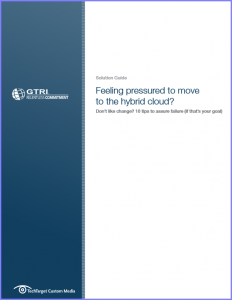One of the longest-lasting traditions in the computer industry is one of stubborn behavior in the face of change. Back in the days when mainframes ruled the earth and information technology (IT) was called management information systems (MIS), there were COBOL-encrusted contrarians who believed that personal computers (PCs) were a fad. They would never catch on, they said. Then came the internet and there were those who believed it would never work because who wants to be connected all the time?
And now, as cloud computing becomes main stream we once again are faced with those who don’t believe it can work. Interesting though since it is anticipated that by 2017, more than 50% of large enterprises will be using hybrid clouds, according to research firm Gartner, Inc.
So in this same spirit, we’ve developed some advice so that you can assure failure when you finally begin to transition to a hybrid cloud environment.
Step No. 1: Don’t Even Think About Increasing Bandwidth and, Whatever You Do, Don’t Do a Bandwidth Capacity Plan
A hybrid cloud requires significant improvements in infrastructure performance and flexibility that legacy data centers may not be able to address. If you really want to make sure your hybrid cloud initiative fails, don’t do a bandwidth plan and watch gleefully as users deal with latency while waiting impatiently for packets that will never arrive.
 Step No. 2: Don’t Bother with Application Performance Monitoring
Step No. 2: Don’t Bother with Application Performance Monitoring
If hybrid clouds proliferate, organizations will increasingly attempt to achieve these benefits across their most important applications, such as e-commerce, online-transaction processing, big data analytics and others. Business leaders will be concerned that application performance is not degraded and, in fact, will be looking for improvement. If you don’t monitor application performance, they’ll never know—and neither will the IT department.
Step No. 3: Forget About Adding Storage Capacity and Ensuring Replication and Backup
If you don’t address the storage challenges of the hybrid cloud, your company will have to keep buying additional drives to keep up with capacity, without necessarily addressing the growing requirements for increased speed and performance. The hybrid cloud will be a money pit, a bottleneck and a big investment that will actually increase the company’s risks of downtime. Put that in your hybrid cloud business plan, and see how it flies.
Step No. 4: Don’t Leverage APIs or Customize in Any Way
Customization and application program interfaces (APIs) are critical to hybrid cloud success because they make life much easier for users and for the IT department, and will lead to a self-service environment where business decision makers can be more involved in building new services and applications. Why would you want that?
Step No 5: No Exit Plan—That’s the Ticket
 Hybrid cloud is a platform for agility and flexibility, so organizations should want to avoid vendor lock-in wherever possible. If you want the hybrid cloud to fail, once you create the plan to migrate mission-critical applications to a hybrid cloud environment, convince management to double down on the bet and move forward without an exit plan. Imagine the horrified looks on the faces of your management team members as they watch problems escalate with no end in sight. Priceless.
Hybrid cloud is a platform for agility and flexibility, so organizations should want to avoid vendor lock-in wherever possible. If you want the hybrid cloud to fail, once you create the plan to migrate mission-critical applications to a hybrid cloud environment, convince management to double down on the bet and move forward without an exit plan. Imagine the horrified looks on the faces of your management team members as they watch problems escalate with no end in sight. Priceless.
Want to learn more about how to avoid these hybrid cloud failures, plus more failures to be wary of? Download GTRI’s free Hybrid Cloud Solution Guide. Or contact us to learn more about hybrid cloud best practices.

